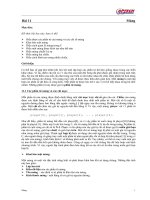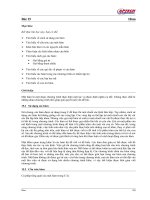Computer concept 2018 module03
Bạn đang xem bản rút gọn của tài liệu. Xem và tải ngay bản đầy đủ của tài liệu tại đây (3.84 MB, 105 trang )
Computer Concepts 2018
Module 3
Networks
Copyright © 2019 Cengage. All rights reserved.
Module Contents
•
•
•
•
•
Section A: Network Basics
Section B: The Internet
Section C: Internet Access
Section D: Local Area Networks
Section E: File Sharing
Copyright © 2019 Cengage. All rights reserved.
Section A: Network Basics
•
•
•
•
•
Communication Systems
Communication Channels
Network Topology
Network Nodes
Communication Protocols
Copyright © 2019 Cengage. All rights reserved.
Section A: Objectives (1 of 2)
•
•
•
•
•
•
Replicate Shannon’s diagram of a general communication system, including all nine labels
Give two examples of PANs, LANs, and WANs
List four examples of wired channels used for networks
State the two wireless channels most commonly used for communication networks
List two advantages and four disadvantages of wireless channels
State what differentiates broadband from narrowband
Copyright © 2019 Cengage. All rights reserved.
Section A: Objectives (2 of 2)
•
•
•
•
•
Draw a diagram showing how data from a smart thermostat could travel over several networks
with different topologies
Compare and contrast mesh and star topologies based on dependability, security, capacity,
expandability, control, and monitoring
List two examples of DTEs and two examples of DCEs
Explain the difference between a modem and a router
List five tasks that are handled by communication protocols
Copyright © 2019 Cengage. All rights reserved.
Communication Systems (1 of 5)
•
•
•
Networks can be classified in many ways; as a network user, you’ll want to keep in mind the idea
of control and how it affects your privacy and security
A network links things together
A communication network (or communication system) links together devices to data and
information can be shared among them
Copyright © 2019 Cengage. All rights reserved.
Communication Systems (2 of 5)
•
In 1948, Claude Shannon, an engineer at Bell Labs, published and article describing a
communication system model applicable to networks of all types
•
His diagram illustrates the essence of a network
Copyright © 2019 Cengage. All rights reserved.
Communication Systems (3 of 5)
•
•
Networks can be classified according to their size and geographic scope
PAN (personal area network)
–
PANs connect smart devices or consumer electronics within a range of about 30 feet (10 meters) and
without the use of wires or cables. The reference to personal indicates that the network serves a single
individual, rather than multiple users. A PAN could be used to sync data from a handheld device to a
desktop computer, ship data wirelessly to a printer, or transmit data from a smartphone to a wireless
headset.
Copyright © 2019 Cengage. All rights reserved.
Communication Systems (4 of 5)
•
–
LAN (local area network)
LANs are data communication networks that connect personal computers within a very limited
geographical area—usually a single building. School computer labs and home networks are examples
of LANs. Wi-Fi networks that you can access in airports, coffee shops, and other public places are
LANs. The in-house networks operated by most businesses are also LANs.
Copyright © 2019 Cengage. All rights reserved.
Communication Systems (5 of 5)
•
–
WAN (wide area network)
WANs cover a large geographical area and usually consist of several smaller networks, which might
use different computer platforms and network technologies. The Internet is the world’s largest WAN.
Other public WANs include telephone systems, cable television systems, and satellite based
communication systems.
Copyright © 2019 Cengage. All rights reserved.
Communication Channels (1 of 10)
•
•
•
A communication channel is the medium used to transport information from one network device
to another
Wired channels transport data through wires and cables
Wireless channels transport data from one device to another without the use of cable or wires
Copyright © 2019 Cengage. All rights reserved.
Communication Channels (2 of 10)
•
Wired channels include twisted pair wires used for telephone land lines, coaxial cables used
for cable television networks, Category 6 cables used for LANs, and fiber-optic cables used
for high-capacity trunk lines
Copyright © 2019 Cengage. All rights reserved.
Communication Channels (3 of 10)
•
•
When you set up a wired connection, you don’t have to worry about hackers intercepting your
data from outside your house
There are ways to tap into a wired network, but they require physical access to the cable or fairly
sophisticated snooping equipment
Copyright © 2019 Cengage. All rights reserved.
Communication Channels (4 of 10)
•
Cables can be shielded against interference and encased in protective casings for installations that are
outdoors and underground.
•
Wired connections are dependable. Their carrying capacity and speed are not affected by airborne
interference from rain, snow, or electrical devices.
•
Wired connections are more secure than their wireless counterparts because a device can join a wired
network only if it is physically connected by a cable.
Copyright © 2019 Cengage. All rights reserved.
Communication Channels (5 of 10)
•
In WANs, wired installation can be costly because cables have to be suspended from poles or buried
underground. They can be damaged by weather events and digging in the wrong place. Repairs to
underground cables require heavy equipment to locate, access, and fix the break.
•
LAN devices connected by cables have limited mobility. Desktop computers tend to be better candidates
for wired connections, whereas laptops, tablets, and handheld devices can retain their mobility when they
are not tethered to a cable.
•
Cables are unsightly, tend to get tangled, and collect dust. Running cables through ceilings, walls, and
floors can be challenging. Cables can also carry electrical surges that have the potential to damage
network equipment.
Copyright © 2019 Cengage. All rights reserved.
Communication Channels (6 of 10)
•
The most widespread wireless channels for communication networks are radio signals and
microwaves
•
•
Most wireless channels transport data as RF signals commonly called radio waves
RF signals are sent and received by a transceiver (a combination of a transmitter and a receiver)
that is equipped with an antenna
Copyright © 2019 Cengage. All rights reserved.
Communication Channels (7 of 10)
Devices used with wireless connections are equipped with transceivers that include a transmitter for
sending data and a receiver for collecting data. A transceiver has an antenna, which may be visible
or may be housed out of sight within a device’s system unit.
Copyright © 2019 Cengage. All rights reserved.
Communication Channels (8 of 10)
•
•
•
Microwaves (the waves themselves, not your oven!) provide another option for transporting data
wirelessly
Microwaves are electromagnetic signals that can be aimed in a single direction and have more
carrying capacity than radio waves
Microwave installations usually provide data transport for large corporate networks
Copyright © 2019 Cengage. All rights reserved.
Communication Channels (9 of 10)
•
•
Advantages of wireless
–
–
–
Mobility
No unsightly cables
Less susceptible to power spikes
Disadvantages of wireless
–
–
–
–
Speed
Range
Security
Licensing
Copyright © 2019 Cengage. All rights reserved.
Communication Channels (10 of 10)
•
•
Bandwidth is the transmission capacity of a communication channel
•
Channels slower than 25 Mbps are classified as narrowband
Network channels that are capable of moving at least 25 megabits of data per second (25 Mbps)
are classified as broadband
Copyright © 2019 Cengage. All rights reserved.
Network Topology (1 of 2)
• In the context of communication networks, topology refers to the
structure and layout of network components, such as computers,
connecting cables, and wireless signal paths
–Point-to-point topology refers to the process of peripheral devices
–
–
–
connecting to a host device using expansion ports, USB cables, or
Bluetooth
Star topology connects multiple devices to a central device
Mesh topology connects multiple devices to each other, either as a full
mesh or as a partial mesh
The less popular bus topology connects devices in a linear sequence
Copyright © 2019 Cengage. All rights reserved.
Network Topology (2 of 2)
Copyright © 2019 Cengage. All rights reserved.
Network Nodes (1 of 3)
•
•
Any device on a network is called a node
Devices on a network are classified as DTEs or DCEs
–
–
DTE stands for data terminal equipment and can be any device that stores or generates data
DCE stands for data communication equipment; these devices control the speed of data over
networks, convert signals from cables to wireless, check for corrupted data, and route data to its
destination
Copyright © 2019 Cengage. All rights reserved.
Network Nodes (2 of 3)
•
A router is a device that controls the flow of data within a network and also acts as a gateway
to pass data from one network to another
•
A modem contains circuitry that converts the data-carrying signals from a digital device to
signals that can travel over various communications channels
Copyright © 2019 Cengage. All rights reserved.
Network Nodes (3 of 3)
•
DCEs such as repeaters, switches, and
hubs can extend the range of your
home network
Copyright © 2019 Cengage. All rights reserved.









